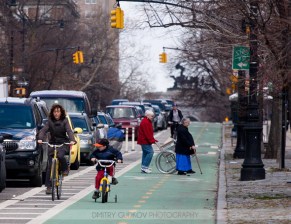City’s Response to PPW Lawsuit Matter-of-Factly Dismantles NBBL Claims
The lawsuit arguing for the removal of the Prospect Park West bike lane is back in court next Wednesday, and Kate Hinds at Transportation Nation has the legal brief in which the New York City Department of Transportation and the city Law Department respond to the charges leveled against DOT.
In new court papers, available above, the city lays out the reasons it decided to install a bike lane on Prospect Park West and proceeds to calmly dismantle the bike lane opponents’ lawsuit. The difference in tone between the city’s methodical argumentation and the insinuations of Gibson Dunn attorney Jim Walden, which were described by an NYU Law professor as “largely public relations,” is particularly striking.
Legally, the city’s lawyers point out that DOT need only have had some rational basis for installing the bike lane — a standard easily surpassed given the long history of public requests for traffic calming and better biking conditions on PPW — and that they ran afoul of neither environmental review regulations nor the city’s landmarks preservation process.
In addition to the legal arguments, the brief goes into detail about DOT’s data collection for the PPW project. From the beginning, the NBBL lawsuit has been used as a tool to undermine public confidence in how DOT selects and evaluates its street safety projects, and for the first time, you can see in this brief DOT’s official, comprehensive response to the allegations that the agency fudged data in evaluating the Prospect Park West bike lane. The brief elucidates in detail how, in fact, NBBL and Walden cherrypicked data to fit their narrative.
For example, when NBBL and Walden alleged that DOT counted crashes that didn’t happen on Prospect Park West, the city explains, they failed to understand how NYPD records traffic crashes at intersections. In those cases, police record one street as the “on” street and the other street as the cross street. Because most crashes occur at intersections, it is standard DOT practice to count a crash as occurring on a given street if it is listed as a “cross street” in the police report. NYPD may, for instance, record a crash that happened at the intersection of PPW and Third Street as happening “on” Third Street, with PPW as the cross street. When studying safety on the PPW corridor, DOT counts such a crash as happening on PPW, while NBBL would have disregarded such a crash, en route to compiling a dataset that doesn’t adhere to the methodology employed by DOT all over the city.
The city also notes that it is standard practice to use three-year averages to measure injury rates before a project is installed. This helps minimize the effect of statistical outliers that crop up when comparing smaller sample sizes.
Even if you only examine the crash stats from the last six months of 2009 and the last six months of 2010, as NBBL and Walden did, the most telling safety statistic — the number of crashes that cause injuries — dropped 50 percent. The plaintiffs never mention that statistic in their complaint. Instead, NBBL and Walden claimed the increase from four injuries on PPW in the second half of 2009 to five injuries in the second half of 2010 proves the lane to be a failure, but the brief explains that this was entirely due to a single crash in 2010 that caused four injuries.
In footnote after footnote, each argument is similarly dissected. As Streetsblog has already reported, because the bike lane is a “traffic control device,” it was specifically exempted from environmental review requirements, a case the city makes in great detail. With regards to the claim that the bike lane required landmarks review, the city shows that while either side of the street might be landmarked, the middle of it isn’t.
Technically, the city lawyers argue that this is all beside the point, in a strictly legal sense, because the bike lane opponents missed their chance to sue at the end of last October; by the time they filed, the city says, the statute of limitations had long passed.
These rational arguments contrast starkly with Walden’s hyperbolic, non-legal prose in his court papers. The city’s lawyers title their sections things like “DOT’s Determination to Install the PPW Project was a Rational Exercise of its Discretionary Authority.” The NBBL lawsuit includes a section titled, “The Ultimate Oxymoron: DOT’s Campaign to Justify the EBL As A ‘Traffic Calming’ Measure.”
Separately, City Council Member Brad Lander and former Brooklyn Community Board 6 Chair Richard Bashner each filed an amicus brief, available in full here and here, in support of the bike lane. Each presented the extensive public process that the bike lane went through before and after construction, stating that they believe the decisions reached by Community Board 6 represent the view of the majority of the area’s residents.
